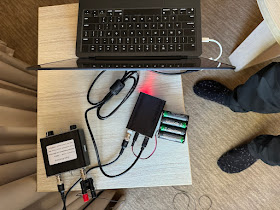Looking at digital modes for talking with people with high local receive noise I noticed Contestia in Fldigi. It's derived from Olivia but has a smaller character set. It only sends upper case letters.
Stephen, VK2BLQ, has fairly high local noise. He's about 700km from me. To check if we have a suitable path for a QSO we both ran WSPR on 40m. He received my 2W at +3dB SNR so we switched to Contestia.
I received him perfectly but he wasn't copying me. It turned out Fldigi defaults to having the squelch turned on. Turning that off and he was able to copy me running down to 5W and probably lower.
My, incorrect, assumption was that Contestia used the extra bits compared to Olivia for better error correction.
Reading from the Fldigi documentation page on Contestia.
"Contestia is a digital mode directly derived from Olivia that is not quite as robust - but more of a compromise between speed and performance. It was developed by Nick Fedoseev, UT2UZ, in 2005. It sounds almost identical to Olivia, can be configured in as many ways, but has essentially twice the speed.
…
Contestia performs very well under weak signal conditions. It handles QRM, QRN, and QSB very well also. It decodes below the noise level but Olivia still outperforms it in this area by about 1.5 - 3db depending on configuration.”
It seems the objective was faster typing speed which I don’t really think is important.
So… thanks for the experiment but I think we should use Olivia in future.
Now, looking at the Olivia page in Fldigi.
The first tip they give is to turn off (or down as much as possible) the squelch.
There’s a bit of talk about different sub-modes but it seems to be about getting faster speed. They say if you’re on 250/8 and want faster (in good signal conditions) go to 500/8.
My question is "what is the best keyboard to keyboard chat mode for low signal to noise radio channels?".














